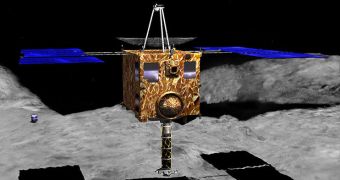Scientists at the Japan Aerospace Exploration Agency (JAXA) announce that their space probe Hayabusa managed to successfully perform one of its last thruster firings. The maneuver was aimed at setting the spacecraft on track for its destined landing site, in Australia. The probe is returning from a near-Earth object (NEO), the asteroid 25143 Itokawa. It should have come back home years ago, but several malfunctions in its engines have prolonged its flight by three years, Space reports.
For a long time, JAXA mission controllers believed that they will never be able to set the spacecraft on a correct course for returning home. All of its four ion thruster engines were damaged or malfunctioned one way or another, and the ship is currently being propelled through the power of all of its engines, after engineers designed and implemented a patchwork of modifications while the probe was still in flight. A while back, it was calculated that Hayabusa would return home on June 13 this year, and the recently-performed TCM-3 operation maneuver seems to confirm that this is indeed the case.
In the coming week, the spacecraft will need to cover the 3.6 million kilometers (2.2 million miles) still separating it from Earth. Once around the planet, it will eject a canister that JAXA experts hope contains some pebbles and meteorite dust. However, this is uncertain, given that the probe failed to fire an onboard projectile mechanism, that was supposed to stir up some dust from the surface of 25143 Itokawa. But researchers hope that its collection canister was able to pick up at least some material samples. The entire spacecraft weighs only 950 pounds (430 kilograms), and is destined to land in the Woomera Test Range, one of the largest such facilities in the world.
“Hayabusa system is going well,” experts at JAXA said recently in a statement. The spacecraft was ahead of its day at the time of launch. It featured technologies that had not been tried out before on spacecrafts, such as, for example, autonomous navigation systems, samplers and a re-entry capsule. The reason why this mission is so important is because the probe managed to reach an asteroid roaming the solar system, collect dust samples, and then take off from its surface again. While around the space rock, Hayabusa experienced a glitch, which made it actually touch down on its surface, rather than just orbit it at close distance.

 14 DAY TRIAL //
14 DAY TRIAL //